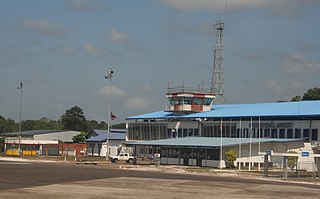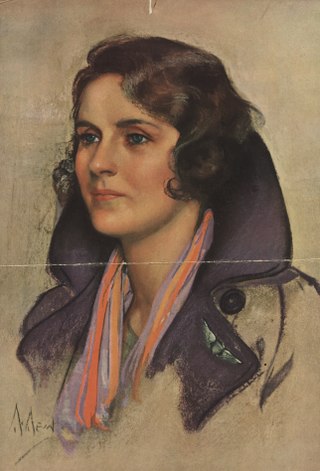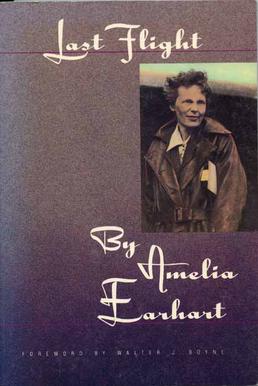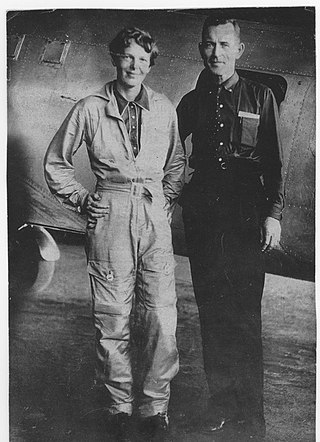
Amelia Mary Earhart was an American aviation pioneer who on July 2, 1937, disappeared over the Pacific Ocean while attempting to become the first female pilot to circumnavigate the world. During her life, Earhart embraced celebrity culture and women's rights, and since her disappearance, she has become a global cultural icon. She was the first female aviator to fly solo non-stop across the Atlantic Ocean and set many other records. She was one of the first aviators to promote commercial air travel, wrote best-selling books about her flying experiences, and was instrumental in the formation of The Ninety-Nines, an organization for female pilots.

Frederick Joseph Noonan was an American flight navigator, sea captain and aviation pioneer, who first charted many commercial airline routes across the Pacific Ocean during the 1930s. As the flight navigator for famed aviator Amelia Earhart in their pioneering attempt at circumnavigating the globe, they disappeared somewhere over the central Pacific Ocean on July 2, 1937.
The Lockheed Model 10 Electra is an American twin-engined, all-metal monoplane airliner developed by the Lockheed Aircraft Corporation, which was produced primarily in the 1930s to compete with the Boeing 247 and Douglas DC-2. The type gained considerable fame as one was flown by Amelia Earhart and Fred Noonan on their ill-fated around-the-world expedition in 1937.

Albert Paul Mantz was a noted air racing pilot, movie stunt pilot and consultant from the late 1930s until his death in the mid-1960s. He gained fame on two stages: Hollywood and in air races.

The Lockheed Model 12 Electra Junior, more commonly known as the Lockheed 12 or L-12, is an eight-seat, six-passenger all-metal twin-engine transport aircraft of the late 1930s designed for use by small airlines, companies, and wealthy private individuals. A smaller version of the Lockheed Model 10 Electra, the Lockheed 12 was not popular as an airliner but was widely used as a corporate and government transport. Several were also used for testing new aviation technologies.

Johan Adolf Pengel International Airport, also known as Paramaribo-Zanderij International Airport, and locally referred to simply as JAP, is an airport located in the town of Zanderij and hub for airline carrier Surinam Airways, 45 kilometres (28 mi) south of Paramaribo. It is the larger of Suriname's two international airports, the other being Zorg en Hoop with scheduled flights to Guyana, and is operated by Airport Management, Ltd./ NV Luchthavenbeheer.
The International Group for Historic Aircraft Recovery (TIGHAR) is an American nonprofit organization based in Pennsylvania. It was founded by Richard Gillespie in 1985. According to TIGHAR's Federal Tax Exemption Form 990 for Non Profits, the organization's mission is to "promote responsible aviation archaeological and historic preservation".

Ruth Rowland Nichols was an American aviation pioneer. She is the only woman yet to hold simultaneous world records for speed, altitude, and distance for a female pilot.

Last Flight is a book published in 1937 consisting of diary entries and other notes compiled by aviation pioneer Amelia Earhart during her unsuccessful attempt that year at flying solo across the Pacific Ocean. Her husband, publisher George Palmer Putnam, edited the collection which was published posthumously as a tribute to his wife.

Elgen Marion Long was a distinguished American aviator, author, and researcher who achieved numerous notable milestones in aviation. Among his impressive accomplishments, Long set fifteen aviation records, including a groundbreaking 1971 flight around the world over both poles, which earned him the FAI Gold Air Medal.

Ann Dearing Holtgren Pellegreno is a professional musician, teacher, author, and lecturer. In 1967, Pellegreno and a crew of three successfully flew the same type aircraft, Lockheed 10 Electra, to complete a world flight that closely mirrored Amelia Earhart's flight plan in 1937. On the 30th anniversary of Earhart's disappearance, Pellegreno dropped a wreath in her honor on tiny Howland Island and returned to Oakland, California, completing the 28,000-mile commemorative flight on July 7, 1967.

Flight for Freedom is a 1943 American drama film directed by Lothar Mendes and starring Rosalind Russell, Fred MacMurray and Herbert Marshall. Film historians and Earhart scholars consider Flight for Freedom an à clef version of Amelia Earhart's life story, concentrating on the sensational aspects of her disappearance during her 1937 world flight. The film's ending speculated that the main character's disappearance was connected to a secret mission on behalf of the U.S. government. As a propaganda film, the Japanese characters in Flight for Freedom were portrayed as devious and evil.

Coast Guard Air Station Miami is an Air Station of the United States Coast Guard located at Opa-locka Executive Airport in Opa-locka, Florida. The station operates the HC-144 Ocean Sentry maritime patrol aircraft and the MH-65 Dolphin helicopter.

Amelia Earhart is a 1976 American biographical drama television film directed by George Schaefer and written by Carol Sobieski. It stars Susan Clark as Amelia Earhart, and John Forsythe as her husband, George P. Putnam.

Amelia Earhart: The Final Flight is a 1994 American biographical television film directed by Yves Simoneau, written by Anna Sandor, and starring Diane Keaton, Rutger Hauer and Bruce Dern. The film is based on the 1987 book Amelia Earhart: A Biography by Doris L. Rich, and depicts events in the life of Amelia Earhart, focusing on her final flight and disappearance in 1937, with her exploits in aviation and her marriage to publisher George P. Putnam being revealed in flashbacks. It aired on TNT on June 12, 1994.

Mercy Plane is a 1939 American aviation crime drama film directed by Richard Harlan and starring James Dunn, Frances Gifford, William Pawley, and Matty Fain. The plot involves military aircraft being stolen by "hot plane" thieves, to be re-sold to new owners, with most of the world at war, presumably to war-torn countries. With location filming done at Alhambra Airport, California, the film features numerous aircraft models, including the Lockheed Model 12 Electra Junior as the "Mercy Plane". Lead actor Dunn, a licensed pilot, did his flying in the film.
Susan Butler is an American journalist and biographer, best known as a biographer of Amelia Earhart.

Linda (Dueler) Finch, also known as Linda Finch Doctor, is an American businesswoman, aviator, and aviation historian from San Antonio, Texas. Finch had 30 years of experience in the construction industry, making prefabricated buildings, and operating healthcare facilities. She began her career managing nursing homes in her twenties and owned several nursing homes in her thirties. Finch became a pilot and purchased an airplane that she used in her nursing-home business. She later added construction firms to her portfolio.
The Amelia Earhart Hangar Museum is an aviation museum located at Amelia Earhart Airport in Atchison, Kansas focused on Amelia Earhart.

Speculation on the disappearance of Amelia Earhart and Fred Noonan has continued since their disappearance in 1937. After the largest search and rescue attempt in history up to that time, the U.S. Navy concluded that Earhart and Noonan ditched at sea after their plane ran out of fuel; this "crash and sink theory" is the most widely accepted explanation. However, several alternative hypotheses have been considered.
















